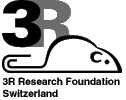
Böhnke M.
Universitäts Augenklinik, Inselspital, Bern
Duration: 1 year End of the Project: 1994
Background and Aim
Currently, the ocular surface toxicity (of eye drops and other substances) is tested by creating a superficial corneal wound in rabbits and observing the healing process. With a new model, a large number of these experiments can be conducted under in vitro conditions. Thus, the number of rabbits used in ocular pharmaceutical research can be significantly reduced.
The purpose of this study is to set up an in vitro epithelial wound healing model without photography and defect area measurement.
Method and Results
A new model was developed for epithelial wound healing study in pig eyes, in which the excimer laser was used for ablation to create an epithelial wound with precise depth and size. A medium perfusion system in intact bulbus helps to maintain the eye ball. 28 pig eyes received photokeratectomy (PKT) with the different diameters of 2.0mm, 1.8mm and 1.5mm, and 70microm in depth. After PKT, the eye balls were placed in the incubator and perfused with TC-199 media by vitreous puncture.
(i) 8 eyes in each group were rinsed with TC-199. The average healing time for 2.0mm group was 31.8 hours; the 1.8mm group was 28.8. hours, and for the 1.5mm group was 25.5 hours.
(ii) - 4 pig eyeballs with PKT of 1.5mm and receiving rinsing with Benzalkonium chloride on epithelial wounds did not heal after 36 hours’ observation.
(iii) - 12 eyeballs without PKT were perfused under the same criteria to evaluate the change of the intraocular pressure (IOP). After 24 hours, the IOP was on the average of 19.0mm Hg.
This study revealed the healing time is proportional to the wound diameter and the healing was retarded by the drug effect. With this model, the drug influences on corneal epithelial wound healing can be evaluated and the result is revealed around 24 hours.